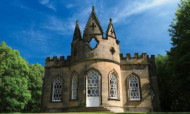
If you love historic buildings and are searching for a holiday, look no further than The Landmark Trust.
The charity takes on historic buildings in danger, carefully restores them, then rents out the stunning venues as holiday homes so they can be enjoyed both inside and out. It means visitors can actually live and breathe history.
The Landmark Trust, which celebrates its 50th anniversary next year, was started by philanthropist John Smith in 1965.
John was a board member on the National Trust, which protects historic homes and gardens and opens them up to the public.
But he realised that while the National Trust was looking after the bigger properties, the smaller ones were falling into ruin and had nobody looking after them.
The Landmark Trust now has almost 200 buildings in Britain in its care, as well as a number in Italy and France.
They range in style from the sober to the spectacular, but each and every one is rich in history and character.
Holidaymakers can choose from clan chiefs’ castles, cotton weavers’ cottages, follies and forts to picturesque pavilions, terrific towers and marvellous medieval longhouses.
There’s also a history lesson or two to be learned from the homes of great writers, such as Browning and Boswell, and the creations of great architects like Pugin, Palladio and Charles Rennie Mackintosh.
Properties range in size from quaint cottages sleeping two people to bigger properties catering for 16. One of the most popular is the elaborate and eccentric Pineapple in Dunmore.
Traditional craft skills and age-old materials are used for restorations to ensure they are as close to the original as possible.
Media assistant Natalie Earl said: “The experience of staying in a Landmark property is something you can’t really put into words.
“We have quite a loyal fanbase who come back year on year. It’s something you won’t experience anywhere else. It’s pretty magical.”
For more information, visit landmarktrust.org.uk.

Enjoy the convenience of having The Sunday Post delivered as a digital ePaper straight to your smartphone, tablet or computer.
Subscribe for only £5.49 a month and enjoy all the benefits of the printed paper as a digital replica.
Subscribe